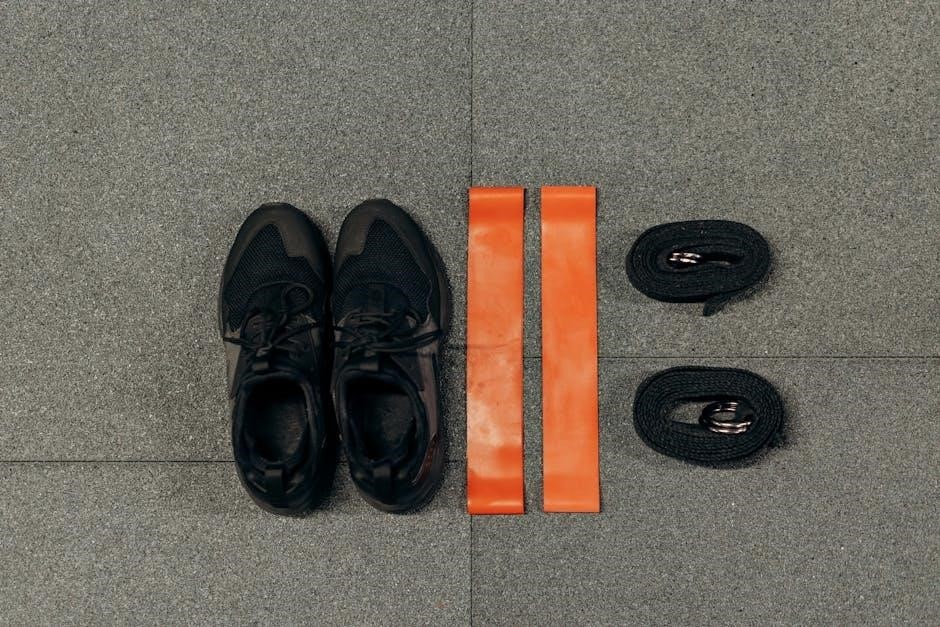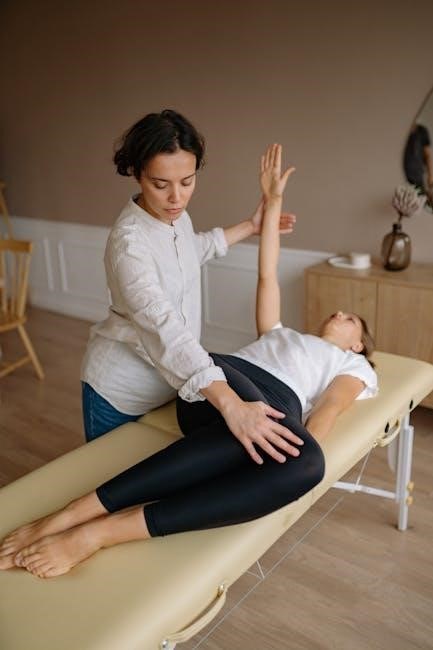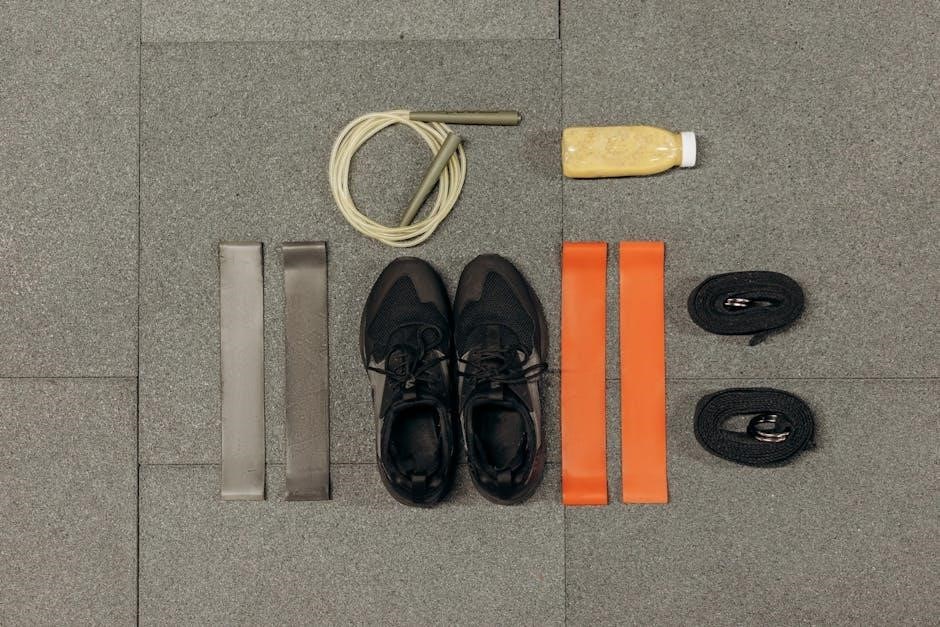The GLA:D program is an evidence-based approach for managing knee and hip osteoarthritis through education and exercise. It offers a structured PDF guide with various exercises‚ including warm-ups and strength training‚ designed to improve joint stability and function.
1.1 Overview of the GLA:D Program
The GLA:D program is an evidence-based treatment plan combining education and exercise for knee and hip osteoarthritis. It focuses on improving joint stability and function through neuromuscular exercises. The program includes a downloadable PDF guide with detailed instructions for exercises like pelvic tilts‚ sit-ups‚ and lunges. Designed for patients with lower limb osteoarthritis‚ it emphasizes core strengthening and functional movements. The structured approach‚ available in PDF format‚ is particularly popular in Australia‚ offering accessible resources for managing symptoms and improving mobility. This comprehensive program is supervised by certified clinicians‚ ensuring safe and effective progression for participants.
1.2 Importance of Exercise in Osteoarthritis Management
Exercise plays a crucial role in managing osteoarthritis‚ as it helps reduce pain‚ improve joint function‚ and enhance overall mobility. The GLA:D program emphasizes the importance of tailored exercises to strengthen muscles‚ improve stability‚ and promote functional movements. Regular physical activity can slow disease progression‚ reduce stiffness‚ and improve quality of life. By focusing on neuromuscular training‚ the program helps patients maintain independence and reduce the need for surgical interventions. The structured exercises in the GLA:D program PDF are designed to address the specific needs of individuals with knee and hip osteoarthritis‚ making it a cornerstone of effective symptom management.

Objectives and Benefits of the GLA:D Program
The GLA:D program aims to improve joint stability‚ reduce pain‚ and enhance functional abilities through tailored exercises. It offers evidence-based methods to manage osteoarthritis effectively.
2.1 Goals of the GLA:D Exercise Program
The primary goals of the GLA:D exercise program are to enhance joint stability‚ improve neuromuscular control‚ and reduce pain in individuals with knee and hip osteoarthritis. By focusing on functional movements and core strength‚ the program aims to restore normal movement patterns‚ preventing further joint degeneration. It also seeks to empower patients with the knowledge and skills needed for long-term self-management of their condition. The structured exercises are designed to improve quality of life by increasing mobility and reducing the need for surgical interventions. Regular participation in the program has shown significant benefits in managing osteoarthritis symptoms effectively.
2.2 Benefits for Patients with Knee and Hip Osteoarthritis
The GLA:D program offers significant benefits for patients with knee and hip osteoarthritis‚ including reduced pain‚ improved joint function‚ and enhanced quality of life. By focusing on neuromuscular exercises‚ it helps restore movement patterns and strengthens muscles around the joints. Participants often experience improved mobility‚ making daily activities easier. The program also delays the need for surgical interventions and reduces reliance on pain medication. Patients gain confidence in managing their condition through education and exercise‚ fostering long-term independence. The structured approach ensures progressive improvements‚ tailored to individual needs‚ leading to better overall health and well-being.

Structure of the GLA:D Program
The GLA:D program is a 6-week structured exercise plan with weekly progression‚ focusing on joint stability and function. It includes warm-ups‚ core strengthening‚ and functional movements‚ guided by a PDF manual.
3.1 Duration of the Program
The GLA:D program is designed to last approximately 6 weeks‚ with each week building on the previous one to gradually improve joint stability and function. This duration ensures that participants can safely progress through the exercises‚ starting with foundational movements and advancing to more complex activities. The structured timeline helps participants stay consistent and motivated‚ while also allowing for proper adaptation and strengthening of the muscles and joints. Supervised sessions are typically held twice a week‚ with additional home exercises recommended to reinforce the program’s objectives. The 6-week framework is well-supported by research and clinical evidence‚ ensuring effectiveness in managing osteoarthritis symptoms.
3.2 Weekly Exercise Plan and Progression
The GLA:D program follows a structured weekly exercise plan tailored to improve joint function and stability; Each week introduces new exercises or progresses existing ones‚ ensuring gradual strengthening and mobility. Participants engage in supervised sessions twice weekly‚ focusing on foundational movements like pelvic tilts and sit-ups‚ followed by functional exercises such as lunges and stair climbing. The program emphasizes proper technique and progression to avoid overloading joints. Certified clinicians adjust the exercises based on individual progress and feedback‚ ensuring a safe and effective experience. Home-based exercises are also recommended to reinforce the program’s goals‚ promoting consistency and long-term benefits for managing osteoarthritis symptoms effectively.

Exercise Categories in the GLA:D Program
The GLA:D program includes warm-up exercises‚ core strengthening‚ functional movements‚ and joint mobility exercises‚ all designed to enhance stability and reduce osteoarthritis symptoms effectively.
4.1 Warm-Up Exercises
The GLA:D program begins with warm-up exercises to prepare the body for physical activity. These exercises focus on gentle movements to increase blood flow and flexibility in the joints‚ particularly in the knees and hips. They are designed to reduce stiffness and improve range of motion. Examples include light walking‚ leg swings‚ and controlled arm circles. The warm-up phase is crucial as it helps prevent injuries and ensures that participants are ready for more intense exercises. By incorporating these simple yet effective movements‚ the GLA:D program sets a foundation for safe and progressive physical activity.
4.2 Core Strengthening Exercises
Core strengthening exercises are a key component of the GLA:D program‚ designed to improve stability and reduce pain in individuals with knee and hip osteoarthritis. These exercises target the muscles of the abdomen‚ lower back‚ and pelvis‚ which play a crucial role in maintaining proper posture and joint alignment. Examples include planks‚ bird-dog exercises‚ and pelvic tilts. By enhancing core strength‚ participants gain better control over their movements‚ which helps reduce stress on the joints and improves overall functional ability. These exercises are performed progressively‚ ensuring they are challenging yet safe for individuals at all stages of osteoarthritis.
4.3 Functional and Positional Movements
Functional and positional movements in the GLA:D program focus on improving mobility and joint function through exercises that mimic daily activities. These movements target the hips‚ knees‚ and lower limbs‚ enhancing strength and flexibility. Examples include bridging‚ side-lying leg lifts‚ and seated forward bends‚ which help restore normal movement patterns. By practicing these exercises‚ participants can better perform tasks like walking‚ climbing stairs‚ and maintaining balance. The exercises are designed to be progressive‚ ensuring they remain challenging yet safe as participants improve. This approach helps reduce pain and improve overall functional ability‚ making everyday activities easier and less straining.

Key Exercises in the GLA:D Program PDF
The GLA:D program PDF includes essential exercises like pelvic tilts‚ sit-ups‚ slide exercises‚ lunges‚ and stair climbing. These movements aim to enhance strength‚ mobility‚ and joint stability.
5.1 Pelvic Tilt Exercises
Pelvic tilt exercises are foundational in the GLA:D program‚ focusing on improving lower back mobility and core stability. They involve gentle tilting of the pelvis to strengthen abdominal muscles‚ enhancing posture and reducing discomfort. These exercises are typically performed in a lying or standing position‚ with controlled movements to ensure proper engagement of the core. The pelvic tilt is often one of the first exercises introduced‚ as it sets the basis for more advanced movements. By incorporating pelvic tilts‚ patients can improve their overall spinal alignment and reduce stiffness‚ making daily activities more manageable. This exercise is particularly beneficial for those with hip or knee osteoarthritis‚ as it promotes joint stability without excessive strain.
5.2 Sit-Up Exercises
Sit-up exercises in the GLA:D program are designed to strengthen core muscles‚ improving spinal stability and posture. They are performed in a controlled manner‚ typically starting from a lying position with knees bent. Patients are guided to lift their shoulders while maintaining proper form to avoid strain. These exercises progressively increase in difficulty to enhance abdominal and lower back strength. Sit-ups are essential for improving functional movements and reducing stiffness in daily activities. They are particularly beneficial for individuals with hip or knee osteoarthritis‚ as they promote better joint alignment and reduce discomfort. The program emphasizes proper technique to maximize benefits and minimize the risk of injury.
5.3 Slide Exercises for Joint Mobility
Slide exercises in the GLA:D program focus on improving joint mobility and reducing stiffness in the hips and knees. These exercises involve gentle‚ controlled movements where patients slide their legs or arms across a surface‚ often in a seated or lying position. Sliding helps maintain joint range of motion without putting excessive strain on the joints. The program includes variations such as lateral slides‚ forward slides‚ and rotational slides‚ each targeting different aspects of joint function. Regular practice enhances flexibility and makes daily activities easier. The exercises are low-impact‚ making them suitable for individuals with osteoarthritis who may have limited mobility or pain during movement.
5.4 Lunge and Stair Climbing Exercises
Lunges and stair climbing exercises in the GLA:D program target strength‚ balance‚ and functional movement; Lunges improve hip and knee strength while enhancing balance and coordination. Stair climbing mimics real-life activities‚ boosting mobility and confidence. Both exercises are progressed gradually to suit individual abilities‚ ensuring safety and effectiveness in managing osteoarthritis symptoms.

Educational Component of the GLA:D Program
The GLA:D program includes patient education on osteoarthritis‚ focusing on symptom management and exercise execution. It provides feedback during exercises to ensure proper technique and safety‚ enhancing overall effectiveness.
6.1 Patient Education on Osteoarthritis
The GLA:D program emphasizes patient education to empower individuals with osteoarthritis. It focuses on understanding the condition‚ managing symptoms‚ and adopting healthy lifestyle habits. Patients learn about the importance of exercise in improving joint function and reducing pain. The program provides clear guidance on proper exercise execution‚ ensuring safety and effectiveness. Certified clinicians offer personalized feedback‚ helping patients understand their limitations and progress. Education also covers strategies for daily activities‚ such as posture and movement techniques‚ to alleviate discomfort. This comprehensive approach ensures patients are well-informed and motivated to take an active role in their care‚ leading to better long-term outcomes.
6.2 Feedback and Instruction During Exercises
Feedback and instruction are critical components of the GLA:D program‚ ensuring exercises are performed safely and effectively. Certified clinicians provide personalized guidance‚ correcting movements and addressing individual needs. Patients receive demonstrations and verbal cues to maintain proper form‚ reducing injury risk and optimizing benefits. The program encourages regular feedback to monitor progress and adjust exercises as needed. This tailored approach helps patients understand their limitations and build confidence in their ability to manage symptoms. By focusing on precise execution‚ the GLA:D program ensures that participants achieve the best possible outcomes while maintaining a safe and structured exercise environment.

Implementation of the GLA:D Program
The GLA:D program is implemented through a structured‚ evidence-based approach combining education and exercise‚ utilizing the provided PDF guide for effective management of osteoarthritis.
7.1 Role of Certified Clinicians
Certified clinicians play a crucial role in the GLA:D program‚ guiding participants through personalized exercise plans and providing feedback to ensure proper technique and progress. Their expertise helps maximize the program’s benefits‚ tailoring exercises to individual needs and fostering a supportive environment for effective osteoarthritis management.
7.2 Supervised vs. Home-Based Exercises
The GLA:D program offers both supervised and home-based exercise options‚ providing flexibility for participants. Supervised sessions‚ led by certified clinicians‚ ensure proper form and personalized feedback‚ enhancing safety and effectiveness. Home-based exercises‚ supported by downloadable PDF guides and video resources‚ allow for convenience and consistency. While supervised sessions provide structured guidance‚ home-based exercises promote independence and long-term adherence. Both approaches emphasize progressive overload and functional movements‚ tailored to individual needs. The program encourages participants to choose the option that best fits their lifestyle‚ ensuring sustained engagement and optimal results in managing osteoarthritis symptoms.
Availability of the GLA:D Program Exercises in PDF Format
The GLA:D program exercises are readily available in PDF format‚ offering easy access to detailed instructions and visual guides for participants worldwide‚ particularly in Australia.
8.1 Downloading the GLA:D Program PDF
The GLA:D program exercises are easily accessible in PDF format‚ allowing participants to download and follow structured routines. The PDF includes detailed instructions‚ visual guides‚ and progression plans for exercises like pelvic tilts‚ sit-ups‚ and lunges. It also covers warm-ups‚ core strengthening‚ and functional movements‚ ensuring a comprehensive approach to managing osteoarthritis. The downloadable material is designed for both supervised and home-based use‚ with clear instructions for proper execution. Certified clinicians often provide access to the PDF‚ ensuring participants adhere to safe and effective practices. This resource is particularly accessible for Australia-based users‚ making it a convenient option for those seeking to improve joint health and mobility.
8.2 Accessibility for Australia-Based Users
The GLA:D program exercises in PDF format are readily accessible to Australia-based users‚ ensuring widespread availability and ease of use. Participants can download the comprehensive guide‚ which includes detailed exercise instructions‚ videos‚ and printable sheets. Certified clinicians in Australia often facilitate access to the program‚ providing supervision and guidance. The structured 6-week exercise plan‚ focusing on joint mobility and strength‚ is particularly beneficial for those managing osteoarthritis. This accessibility helps reduce barriers‚ enabling individuals to improve their joint health and mobility effectively. The program’s reach in Australia is further enhanced by its alignment with local healthcare standards and patient needs.

Evidence Supporting the GLA:D Program
The GLA:D program is supported by extensive research‚ emphasizing education and targeted exercises. Studies demonstrate significant improvements in symptoms and functional outcomes for osteoarthritis patients‚ providing strong evidence for its effectiveness.
9.1 Research on Exercise and Osteoarthritis
Research underscores the effectiveness of exercise in managing osteoarthritis symptoms. The GLA:D program is rooted in studies demonstrating that structured exercise improves joint function and reduces pain. Exercises like neuromuscular training‚ core strengthening‚ and functional movements are proven to enhance stability and mobility in patients with knee and hip osteoarthritis. These findings highlight the importance of tailored programs in addressing OA progression and improving quality of life. The evidence-based approach of GLA:D aligns with clinical recommendations‚ emphasizing the role of physical activity in symptom management and functional recovery.
9.2 Patient Outcomes and Symptom Management
Patients participating in the GLA:D program often experience significant improvements in joint function and symptom relief. The structured exercises‚ such as pelvic tilts and lunges‚ enhance stability and reduce pain. Many report improved mobility‚ enabling better performance of daily activities. The program’s focus on neuromuscular control and strength helps manage osteoarthritis symptoms effectively. Clinicians observe consistent positive outcomes‚ with patients achieving measurable reductions in pain and functional limitations. These improvements contribute to a better quality of life‚ making the GLA:D program a highly recommended intervention for knee and hip osteoarthritis management.

Exercise Diary and Progress Tracking
The GLA:D program includes an exercise diary to monitor progress and adherence. It helps track daily routines‚ ensuring consistent practice and proper supervision by certified clinicians.
10.1 Purpose of the Exercise Diary
The exercise diary in the GLA:D program serves as a tool for documenting daily progress‚ adherence‚ and feedback. It helps patients stay motivated and informed‚ ensuring they follow the prescribed exercises correctly; The diary also allows certified clinicians to monitor progress‚ provide guidance‚ and adjust the program as needed. By tracking exercises and outcomes‚ patients can better understand their improvement and maintain consistent practice. This personalized approach enhances the effectiveness of the program and supports long-term management of osteoarthritis symptoms.
10.2 How to Use the Diary for Better Results
Using the exercise diary effectively involves consistent documentation of daily activities‚ noting the number of repetitions and any challenges faced. Patients should record how exercises feel‚ any discomfort‚ and progress over time. Regular reviews with certified clinicians ensure personalized adjustments and feedback. The diary also helps set realistic goals‚ fostering accountability and motivation. By tracking adherence‚ individuals can identify patterns and stay committed to their routine. Proper use of the diary enhances the program’s effectiveness‚ leading to improved joint function and symptom management. This structured approach ensures patients maximize their benefits from the GLA:D program.

Additional Resources for the GLA:D Program
The GLA:D program offers video guides‚ printable sheets‚ and a detailed PDF manual‚ providing comprehensive support for patients to perform exercises correctly and track their progress effectively.
11.1 Video Guides for Exercise Execution
The GLA:D program provides video guides to ensure proper execution of exercises. These videos demonstrate techniques for pelvic tilts‚ sit-ups‚ and lunges‚ helping users maintain form and safety. Accessible online‚ they complement the PDF manual‚ offering visual instructions for core strengthening and functional movements. Videos are particularly useful for home-based participants‚ ensuring exercises are performed effectively without supervision. They cover joint mobility slides and stair climbing‚ aiding in symptom management. This resource enhances adherence to the program‚ promoting better outcomes for knee and hip osteoarthritis patients.
11.2 Printable Exercise Sheets
The GLA:D program offers comprehensive printable exercise sheets in PDF format‚ providing detailed instructions for each exercise. These sheets cover warm-up routines‚ core strengthening‚ and functional movements‚ ensuring clarity and ease of use. Designed for both clinicians and patients‚ they include visual aids and step-by-step guidance‚ making it easier to follow the program structure. The sheets are particularly beneficial for home-based exercises‚ allowing users to track their progress effectively. Available for download‚ they are part of the program’s commitment to accessibility‚ ensuring that participants in Australia and elsewhere can adhere to the regimen and achieve optimal results for managing osteoarthritis symptoms.
The GLA:D program is a proven‚ effective approach for managing osteoarthritis‚ offering structured exercises and education. Start today to improve joint health and overall well-being.
12.1 Summary of the GLA:D Program Benefits
The GLA:D program offers a comprehensive approach to managing osteoarthritis‚ providing significant benefits such as reduced pain and improved joint function. By focusing on education and tailored exercises‚ it empowers patients to take control of their condition. The program’s structured PDF guides‚ including warm-ups‚ core strengthening‚ and functional movements‚ ensure accessibility and ease of use. Supervised by certified clinicians‚ it guarantees a safe and effective experience. With downloadable resources and an exercise diary‚ participants can track progress and maintain consistency. Overall‚ the GLA:D program is a valuable tool for enhancing quality of life and managing osteoarthritis symptoms effectively.
12.2 Encouragement to Start the Program
Starting the GLA:D program is a proactive step toward managing osteoarthritis and improving your quality of life. With its evidence-based exercises and educational resources‚ the program equips you with the tools to reduce pain and enhance mobility. The structured PDF guides‚ including pelvic tilts‚ sit-ups‚ and slide exercises‚ are easy to follow and tailored to your needs. Certified clinicians provide expert supervision‚ ensuring a safe and effective experience. By committing to the program‚ you can take control of your condition‚ improve joint function‚ and enjoy a more active lifestyle. Embrace this opportunity to strengthen your body and regain confidence in your daily activities.